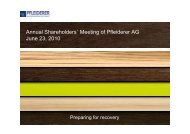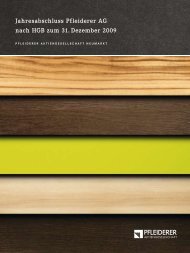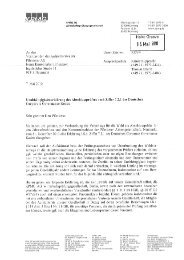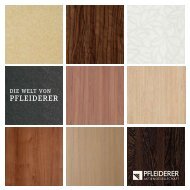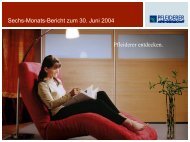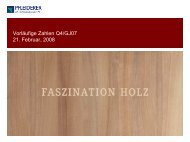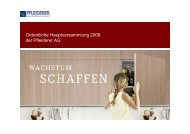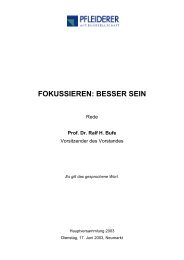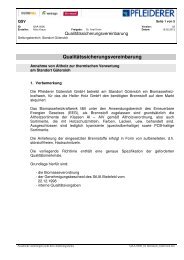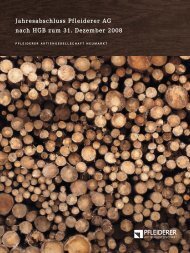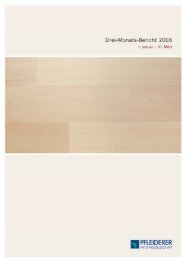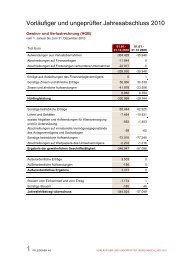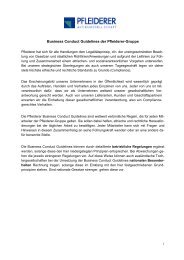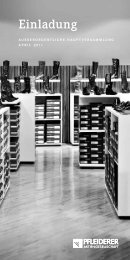Discover our products! (PDF, 710 KB) - Pfleiderer AG
Discover our products! (PDF, 710 KB) - Pfleiderer AG
Discover our products! (PDF, 710 KB) - Pfleiderer AG
Create successful ePaper yourself
Turn your PDF publications into a flip-book with our unique Google optimized e-Paper software.
the world of<br />
<strong>Pfleiderer</strong>
content<br />
04<br />
16<br />
09<br />
15 20<br />
03 Welcome to the<br />
world of <strong>Pfleiderer</strong>!<br />
particleboard<br />
04 How particleboard is produced<br />
06 Particleboard as a universal talent<br />
mdf/hdf<br />
08 Wood from the pressure cooker<br />
10 Platform for creative ideas<br />
hpl<br />
12 Taste is many-sided –<br />
like <strong>our</strong> decorative surfaces<br />
14 Looking good is not enough<br />
laminate<br />
16 Immune to everyday chaos<br />
18 Paper-and-glue sandwich<br />
20 The many sides of laminate floors<br />
22 Glossary
ohspan<br />
mdf/hdf<br />
hpl<br />
laminat<br />
Welcome to the<br />
world of <strong>Pfleiderer</strong>!<br />
Feel free to take a look around: the shelf<br />
from which you pluck a book, the worktop<br />
on which y<strong>our</strong> computer stands, the floor<br />
on which you walk. You can see <strong>our</strong> <strong>products</strong><br />
everywhere you look.<br />
<strong>Pfleiderer</strong> is one of the worldwide leading<br />
manufacturers of engineered wood, surface<br />
finished <strong>products</strong> and laminate flooring. But<br />
what exactly do these terms mean Accompany<br />
us on a j<strong>our</strong>ney through the world of<br />
<strong>Pfleiderer</strong> and meet <strong>our</strong> <strong>products</strong> closeup.<br />
We will show you, for example, the manufacturing<br />
processes involved in coatings and<br />
laminate flooring, and explain the difference<br />
between particleboard and medium-density<br />
fiberboard.<br />
working with a regenerative raw material<br />
For all the differences between <strong>our</strong> <strong>products</strong>,<br />
they still always have one thing in common:<br />
we work with a regenerative raw material –<br />
and are always acutely aware of <strong>our</strong> responsibilities<br />
associated with this. In manufacturing<br />
<strong>our</strong> <strong>products</strong>, we use wood from sustained<br />
forestry s<strong>our</strong>ces or recycling in the form of<br />
sawmill by-<strong>products</strong> or natural used wood,<br />
for example. The suppliers of these types of<br />
wood are mainly owners of forest plantations<br />
and sawmills. We never use tropical woods.<br />
We reduce the environmental effects of <strong>our</strong><br />
work with wood that arise during the production<br />
process to a responsible and absolute<br />
minimum. Along with quality and safety, we<br />
regard the environment as a firm component<br />
of <strong>our</strong> corporate philosophy. For this reason,<br />
we have specified guiding principles for these<br />
areas which commit us to active involvement.<br />
In this way, we contribute towards preserving<br />
forests and achieving an improved ecological<br />
balance.
4<br />
How particleboard is produced<br />
Regardless of how <strong>our</strong> suppliers deliver wood to us – at the end of the manufacturing<br />
process, a versatile particleboard is ready for use in furniture construction or interior design.<br />
chipping<br />
Large, small, thick or thin: most of the wood used by the<br />
<strong>Pfleiderer</strong> Group for particleboard production comes from<br />
sawmill by-<strong>products</strong>. They arrive at <strong>our</strong> plants in variously<br />
sized lots (see picture). During the process of chipping, the<br />
first step involves a machine molding the wood into the desired<br />
shape. But even after this process, chips still display<br />
various sizes: smaller parts land in the top layer of the board<br />
while larger bits go into the core.<br />
drying and sorting<br />
The chips must not be damp for<br />
the next steps involved in the<br />
manufacturing process. For this<br />
reason, drum-type dryers extract<br />
moisture from the wood (see<br />
picture). This is followed by the<br />
sifting process where rough and<br />
fine chips are separated; sorting<br />
plants then remove any sand or<br />
metal particles.
particleboard<br />
mdf/hdf<br />
hpl<br />
laminate<br />
5<br />
what is particleboard<br />
Particleboard comprises wood chips and glue. The<br />
areas of furniture design and interior design are<br />
now inconceivable without particleboard as a base<br />
and construction material. It can be used in a wide<br />
variety of applications – one important reason why<br />
particleboard has developed to become the most<br />
important wooden material in terms of volume.<br />
particleboard at pfleiderer:<br />
Business Unit Kunz<br />
<strong>Pfleiderer</strong> Grajewo<br />
<strong>Pfleiderer</strong> Industry<br />
<strong>Pfleiderer</strong> OOO Russia<br />
Uniboard<br />
wodego<br />
pressing<br />
Glue is added to the chips. The materials are<br />
mixed and form a so-called “chip cake”. And<br />
like a real cake, the chip cake also needs to<br />
be heated well. At 250°C and under high pressure,<br />
a press ensures the required composition<br />
(see picture). The panels are then allowed<br />
to cool in large star coolers.<br />
cutting and packing<br />
A machine smoothens the surfaces and<br />
sands them to the exact desired board thickness.<br />
The customer specifies the requisite<br />
size and a saw cuts them to the right length.<br />
All that remains is for the boards to be packaged<br />
and then they’re ready for delivery and<br />
further processing – perhaps as shelves, as<br />
floor panels or as kitchen cabinet fronts.
6<br />
Particleboard as a universal talent<br />
On the wall, floor or as shelving: hardly any other building material<br />
is as versatile and flexible as particleboard. In the world of <strong>Pfleiderer</strong>,<br />
we show you just how different the production and areas of application<br />
of particleboard can be.<br />
raw particleboard<br />
Raw particleboard is regarded<br />
as an all-round talent<br />
among base and construction<br />
materials and is therefore<br />
also used in the area of interior<br />
design (for example paneling<br />
walls and ceilings). The<br />
boards are easy to process<br />
and are also available in special<br />
formats and thicknesses<br />
where required.<br />
melamine-faced<br />
particleboard<br />
Particleboard is also available<br />
in a variety of different colors:<br />
if a particleboard is coated<br />
using decorative paper previously<br />
dipped in melamine<br />
resin, it is referred to as<br />
melamine-faced particleboard.<br />
When subjected to<br />
pressure and heat, the melamine<br />
film is directly combined<br />
with the board in a<br />
short-cycle press, thus forming<br />
a load-bearing synthetic<br />
surface. The furniture industry<br />
uses melamine-faced particleboard<br />
in applications that<br />
are not subject to excessively<br />
heavy loads such as kitchen<br />
cabinet fronts or shelving, for<br />
example.
particleboard<br />
mdf/hdf<br />
hpl<br />
laminate<br />
7<br />
floor panels<br />
Floor panels usually let themselves<br />
be walked all over. Because<br />
raw particleboard featuring<br />
tongue and groove<br />
joints often serve as bases<br />
for carpets or other flooring<br />
materials. Gluing the tongue<br />
and groove connection provides<br />
a practically joint-free<br />
surface upon which flooring<br />
materials can be laid without<br />
further preparation. Floor<br />
panels are also suitable for<br />
paneling or reinforcing walls,<br />
ceilings and roof areas.<br />
multi-functional panels<br />
As the name suggests, multifunctional<br />
panels (MFP) are<br />
true all-rounders in the area of<br />
wooden construction. The<br />
panels comprise consistently<br />
long and slim-pressed chips<br />
which are scattered randomly<br />
and glued using high-quality<br />
melamine-reinforced urea resins.<br />
Thanks to high strength in<br />
longitudinal and horizontal directions<br />
as well as the high<br />
moisture resistance offered by<br />
these panels, they are extremely<br />
stable and capable of<br />
bearing high loads. They are<br />
therefore particularly suitable<br />
as construction materials in<br />
the field of trade-fair construction<br />
and interior design.<br />
pyroex<br />
Wood burns well. And this is<br />
exactly why the <strong>Pfleiderer</strong><br />
Group has developed a type of<br />
particleboard which does not<br />
burn as fast. The Pyroex panels<br />
are low-flammable engineered<br />
wood <strong>products</strong> and combine all<br />
of the advantages of particleboard<br />
such as high strength<br />
and multiple decorative coating<br />
possibilities providing additional<br />
safety in the event of a fire.<br />
The primary area of application<br />
of Pyroex panels includes interior<br />
cladding of rooms in public<br />
buildings as well as rooms with<br />
a higher fire risk, e.g. laboratories,<br />
petrol station retail outlets<br />
or television studios.
8<br />
Wood from the pressure cooker<br />
Medium-density and high-density fiberboard differs from particleboard<br />
by its particularly smooth surface. The reason for this is easy to find<br />
by taking a look at the production process.<br />
The production of medium-density and highdensity<br />
fiberboard essentially corresponds<br />
to that of particleboard – with one decisive<br />
difference: the wood is not milled to chips and<br />
then subjected to further processing but rather<br />
ground down to the wood fibers. Then<br />
chips are added in a type of oversized pressure<br />
cooker which softens the wood. This enables<br />
the refiner, which forms the next step of<br />
the manufacturing process, to easily separate<br />
the wooden chips down to the fibers.<br />
prepared for the twin presses<br />
Like in the manufacturing process for particleboard,<br />
the wood fibers are then dried and<br />
glued, sorted and spread. The mass is directed<br />
into a cold pre-press in order to be molded<br />
into the desired thickness. This step serves as<br />
preparation for the twin presses which compress<br />
the wood-glue mixture at high temperatures.<br />
In the case of high-density fiberboard,<br />
more wood is used during the pressing process<br />
with the result that higher densities are<br />
achieved than for medium-density fiberboard.<br />
cool down<br />
The boards can then be trimmed, after which<br />
they are fed into the star cooler to cool down<br />
followed by a period of one to three days in<br />
the conditioning store. A sanding machine provides<br />
the panels with their final smoothness<br />
before they are packaged and dispatched.
particleboard<br />
mdf/hdf<br />
hpl<br />
laminate<br />
9<br />
1<br />
2<br />
3<br />
6<br />
4<br />
5<br />
7<br />
9<br />
21<br />
20<br />
8<br />
18<br />
19<br />
13<br />
14<br />
12<br />
11<br />
10<br />
15<br />
17<br />
16<br />
Flowchart of the manufacturing process<br />
of MDF on a continuous press<br />
1 debarker<br />
2 wood-hog<br />
3 disk refiner<br />
4 pulper for large chips<br />
5 washer<br />
6 chip silo<br />
7 preheater<br />
8 defibrator<br />
9 screener<br />
10 mat former<br />
11 metal detector with<br />
upstream permanent<br />
magnets<br />
12 cold prepress<br />
13 exhaust<br />
14 reject separation<br />
15 double band press<br />
16 edge trimming saw<br />
17 crosscut saw<br />
18 starcooler<br />
19 conditioning store<br />
20 sander<br />
21 sorting stacker
10<br />
Platform for creative ideas<br />
With its elegant appearance, optimum density distribution and smooth surface,<br />
medium-density fiberboard sets news trends in the area of interior design.<br />
An MDF board is the perfect toy for creative<br />
interior designers: the fine surface structure<br />
is ideal for a wide variety of design options<br />
and essentially makes MDF an attractive<br />
board. Thanks to the extremely fine surface,<br />
the coating appears consistent, of high quality<br />
and lends the decorative appearance even<br />
more expressive power.<br />
But even without a decorative surface, a simple<br />
MDF board can come across as elegant<br />
and attractive. In the world of <strong>Pfleiderer</strong>, this<br />
future-oriented design element is also available<br />
in the variant MDF black. The black<br />
dyed-through material communicates an elegant<br />
impression both in terms of feel and visual<br />
appearance. But their surface structure<br />
is not the only reason MDF boards have developed<br />
to become one of the most popular<br />
engineered wood around.<br />
With the <strong>Pfleiderer</strong> MDF flex product variant,<br />
curved, circular und wave-shaped design<br />
constructions do not present a problem and<br />
require only minimum effort in terms of production<br />
and further processing. The decisive<br />
advantage of this extraordinary engineered<br />
wood product: thanks to the particularly<br />
small bending radius, even circular models<br />
have a graceful effect.
particleboard<br />
mdf/hdf<br />
hpl<br />
laminate<br />
11<br />
glue holds the world<br />
of pfleiderer together.<br />
The quality of the resin essentially determines<br />
the stability and strength of the<br />
boards. Our Polish subsidiary Silekol<br />
supplies all of <strong>our</strong> Eastern European<br />
plants and some of <strong>our</strong> Western European<br />
ones with glue.<br />
We usually use a mixture of urea, melamine<br />
and formaldehyde in <strong>our</strong> production.<br />
Formaldehyde is a chemical compound<br />
which is contained in natural<br />
wood and plays a key role as a binding<br />
agent in many industrial areas. There are<br />
limits for formaldehyde emissions which<br />
are monitored constantly by independent<br />
test institutes and to which the <strong>Pfleiderer</strong><br />
Group is also strictly committed. In<br />
Germany, for example, the E1 standard<br />
(to DIN EN 13986) applies for all boards.<br />
E1 means that the value of formaldehyde<br />
emissions may not exceed 0.1 ppm*<br />
(statutory-defined maximum value).<br />
*1 ppm means one “part per million”. Accordingly, particleboard<br />
may emit a maximum of 1000th particle of formaldehyde<br />
per cubic meter of air.<br />
what is mdf<br />
If you run y<strong>our</strong> hand along the surface of particleboard<br />
and then over medium-density fiberboard<br />
(MDF), you will immediately notice the difference<br />
between the two wooden materials. The<br />
particleboard is somewhat rough to the touch<br />
while the MDF is completely smooth. Instead of<br />
wood chips as used in particleboard, wood fibers<br />
are used in the production of MDF. This makes<br />
the board very homogeneous, giving it a consistent<br />
structure and a very smooth surface. MDF is<br />
also heavier than particleboard as it has a higher<br />
density. As a result of these material properties,<br />
MDF is particularly suitable for three-dimensional<br />
furniture fronts as well as for painted or highgloss<br />
surfaces.<br />
what is hdf<br />
Like MDF, high-density fiberboard (HDF) also comprises<br />
compressed wood fibers and glue joined<br />
under pressure and heat. However, HDF is even<br />
denser than MDF, i.e. it is compressed under<br />
higher pressure: this makes it harder and therefore<br />
more durable. But the board itself is comparably<br />
thin. For this reason, HDF is used where<br />
the material is subject to high loads while material<br />
thickness should be as low as possible. HDF<br />
often serves as base panel for laminate flooring,<br />
for example.<br />
mdf and hdf in the world of pfleiderer:<br />
Business Unit Kunz Thermopal<br />
<strong>Pfleiderer</strong> Grajewo Uniboard<br />
<strong>Pfleiderer</strong> Industry wodego
12<br />
Taste is many-sided –<br />
like <strong>our</strong> decorative surfaces<br />
High pressure laminate is a real quick-change artist: First it presents itself in the appearance<br />
of cool stone then as an absolutely natural wood structure. How does that work<br />
impregnation<br />
The core paper serves as the main core of the<br />
laminate, while the decor paper determines<br />
the design of the High Pressure Laminate<br />
(HPL) that will later be produced. In a continuous<br />
process, the paper is passed through a<br />
resin bath into the drying channel and then<br />
cut into individual sheets.<br />
core and decor laying room<br />
Depending on the desired thickness of the<br />
laminate, the required number of core paper<br />
sheets is now laid up together. A transparent,<br />
impregnated paper sheet (overlay) is placed<br />
on top of the decor paper. Finally, a textured<br />
steel plate determines the feel and appearance<br />
of the HPL surface texture.<br />
hpl press<br />
Now the prepared core and decor impregnated<br />
papers come together for the first time,<br />
are laid up together and inserted into the<br />
press, where through a combination of pressure<br />
and temperature a laminate sheet is<br />
created. The actual HPL is now ready.<br />
element press<br />
The laminate sheets are glued onto particleboard<br />
and inserted into the press. There,<br />
the glue quickly hardens under the effect<br />
of pressure and temperature. Beforehand<br />
the particleboard must be processed – i.e.<br />
sanded, hardened and profiled.
particleboard<br />
mdf/hdf<br />
hpl<br />
laminate<br />
13<br />
production line<br />
The overhanging laminate is<br />
plasticized by means of heat,<br />
bent around the profiled edge of<br />
the particleboard (post forming)<br />
and then glued. A special hotmelt<br />
adhesive seals the butt<br />
joint between the decor and the<br />
reverse foil – and thus the board<br />
is fully sealed against moisture<br />
and is finished.<br />
what is hpl<br />
High-pressure laminate (HPL) is an extremely durable surface<br />
for applications of furniture and interior design. It is used<br />
wherever surfaces are subject to particular loads. One example<br />
of the use of HPL is the kitchen worktop. A wide selection<br />
of decorative finishes means HPL offers multiple possibilities<br />
to design living space in a very individual manner.<br />
hpl in the world of pfleiderer:<br />
Duropal<br />
Thermopal
14<br />
Looking good is not enough<br />
In the area of decorative interior design, decisive roles are played by decorative<br />
variety and high product quality as well as by innovations and functions. This<br />
represents a creative playground where designers of <strong>Pfleiderer</strong> high-pressure<br />
laminates can let their ideas run free. We open the door to the workshop of ideas.<br />
laminate originals<br />
© Soenne, Aachen<br />
The horse’s mane flows in the wind, the<br />
jockey’s eyes are firmly set on the finishing<br />
line: scenes in the Atlantic Hotel at the racec<strong>our</strong>se<br />
in Bremen. The <strong>Pfleiderer</strong> subsidiary<br />
Thermopal offers its customers the opportunity<br />
to have individual motifs pressed onto<br />
laminate, thus demonstrating the versatility<br />
of HPL. State-of-the-art printing technology is<br />
applied in the process for this special product<br />
called “Individual”. And the process involved<br />
in producing this individual decor is extremely<br />
simple: all that is required is digital data of<br />
a reproducible photo or slide. This is used to<br />
generate motif templates which are printed<br />
onto special paper by means of data transfer,<br />
pressed as HPL and finally – if desired – the<br />
appropriate base material is glued on. This<br />
transforms every project into an unmistakable<br />
original.
particleboard<br />
mdf/hdf<br />
hpl<br />
laminate<br />
15<br />
no chance for bacteria: duropal microplus®<br />
Whether you grasp the bar,<br />
lean on the reception at y<strong>our</strong><br />
doctor’s or rummage through<br />
a shop’s shelve: bacteria lurk<br />
everywhere and are transmitted<br />
in no time at all. Chemical<br />
cleaning agents with aggressive<br />
substances are rarely successful<br />
even when applied repeatedly<br />
– not to mention the<br />
fact that they represent pollutants<br />
affecting both people and<br />
the environment. Our designers<br />
have solved this problem: the<br />
integrated hygiene protection<br />
feature displayed by the Duropal<br />
microPLUS ® antibacterial<br />
HPL surface combats bacteria<br />
actively. Duropal microPLUS ®<br />
has been proven to reduce the<br />
formation of germs by more<br />
than 99 per cent within 24<br />
h<strong>our</strong>s and is therefore particularly<br />
suitable for use in kitchens,<br />
laboratories, hospitals and<br />
swimming pools. When germs<br />
encounter the HPL surface featuring<br />
microPLUS ® technology,<br />
the protective film destroys key<br />
functions in the micro-organisms.<br />
Nor do scratches or wear<br />
have any impact on the antibacterial<br />
effect.<br />
crystal stone<br />
If you run y<strong>our</strong> fingers along the<br />
“Crystal Stone” decor on a Duropal<br />
HPL surface, you can feel<br />
little bumps and recesses which<br />
are reminiscent of a rock face.<br />
Unlike other HPL surfaces, this<br />
stone reproduction displays an<br />
intentionally irregular structure.<br />
The decor feels like a real stone<br />
slab while offering the advantages<br />
of a durable HPL product.
16<br />
what is laminate<br />
Wood, paper, glue: These are the<br />
primary components of a laminate<br />
floor. It sounds simple – but it isn’t.<br />
In the world of <strong>Pfleiderer</strong>, a whole lot<br />
of technology is applied in manufacturing<br />
this popular flooring. The surface<br />
of laminate flooring is achieved<br />
using multi-layer technology applied<br />
under heat and high pressure and<br />
ensuring durability and stability. The<br />
specially-developed, moisture-resistant<br />
HDF base material forms the<br />
middle layer. An insulating base as a<br />
third layer is directly linked to the<br />
underside of the panel to which the<br />
laminate panel is applied. Laminate<br />
flooring can be laid anywhere, including<br />
stairs but excluding bathrooms<br />
or rooms with a floor drain.<br />
laminate at pfleiderer:<br />
Pergo<br />
Uniboard
particleboard<br />
mdf/hdf<br />
hpl<br />
laminate<br />
17<br />
Immune to everyday chaos<br />
Everyday chaos can soon leave traces on conventional floors. A laminate floor from<br />
the <strong>Pfleiderer</strong> Group is not that sensitive however. Pergo is regarded as the inventor<br />
of laminate floors and has continued to develop new product features.<br />
durability<br />
In the world of <strong>Pfleiderer</strong>, laminate floors comprise<br />
a surface which is as resistant as titanium.<br />
The patented TitanX surface comprises<br />
several layers which ensure resistance to<br />
abrasion, impact and scratches. An additional<br />
useful layer featuring aluminum-oxide particles<br />
protects the floor from scratches while<br />
moisture-resistant base materials and the<br />
dense sealing system protect the floor from<br />
penetration by liquids.<br />
sound absorption<br />
All Pergo floors have an insulation backside<br />
which is directly linked with the panel. This<br />
integrated technology called SoundBloc ensures<br />
higher sound-insulating features than<br />
with conventional loose underlayment materials.<br />
SoftTech, new from 2008, also involves an additional<br />
sound-insulating layer applied in the laminate<br />
itself directly under the laminate surface.<br />
handling<br />
Laminate floors are easy to install. Thanks to<br />
the integrated insulation backside and glueless<br />
click connections, amateur handymen<br />
can easily lay Pergo floors, as neither glue<br />
nor an additional underlayment material is required.<br />
The strong connection means that no<br />
dirt particles can penetrate the joints making<br />
the floor easy to care for.<br />
hygiene<br />
Some Pergo floors are antibacterial. But chemicals<br />
do not play a role here. Instead, a very<br />
small amount of silver is added in the floor surface<br />
with the result that bacteria are unable to<br />
grow as they do not find any nutrition in an entirely<br />
natural, fast and tried-and-tested manner.<br />
This feature is particularly attractive for hightraffic<br />
areas such as hotels and shops and for<br />
areas requiring high hygiene such as hospitals<br />
and laboratories.
18<br />
Paper-and-glue sandwich<br />
A laminate floor has to<br />
be able to cope with quite<br />
a lot of impact during its<br />
lifetime. And to make sure<br />
it keeps its good looks and<br />
isn‘t marked by scratches<br />
or discoloration, <strong>our</strong><br />
production facilities take<br />
the greatest care and use<br />
state-of-the-art technology.<br />
layer for layer<br />
Every single layer in a laminate<br />
floor has its own special task.<br />
The top layer, which consists of<br />
several resin-saturated papers is<br />
the decorative side or design –<br />
it gives the floor its unique appearance.<br />
The overlay, the outer<br />
layer, provides stability and<br />
protection. It is coated with<br />
wear-resistant melamine resin as<br />
it has to be extremely durable.<br />
under pressure<br />
The core in the middle of the<br />
laminate floor sandwich is made<br />
of pressure-resistant engineered<br />
wood such as MDF, HDF or particleboard.<br />
The bottom layer provides<br />
noise insulation. A large<br />
machine presses the layers together<br />
under pressure and at an<br />
extremely high temperature.
particleboard<br />
mdf/hdf<br />
hpl<br />
laminate<br />
19<br />
dpl and hpl<br />
The laminate floor is compressed<br />
and ready for use. There are<br />
mainly two different production<br />
processes: DPL (direct pressure<br />
laminate) and HPL (high pressure<br />
laminate). With DPL, the layers<br />
are all pressed together at the<br />
same time. If HPL is required, the<br />
overlay and the decorative paper<br />
together with one or more core<br />
papers are pressed together –<br />
that is to say, the high pressure<br />
laminate. After that, the high<br />
pressure laminate and the core in<br />
the middle of the laminate floor<br />
with the bottom layer are all<br />
bonded together to the finished<br />
product, a HPL laminate floor.<br />
precise cut<br />
Once pressed or bonded, the laminate<br />
floor is taken to a milling machine<br />
(see picture above), where<br />
the boards are cut to panels as required<br />
for installation. The latest<br />
technology guarantees maximum<br />
precision (see picture below). The<br />
more accurate the machine is, the<br />
more precisely and easily the floor<br />
will be to install - and there will be<br />
no irritating gaps.<br />
ready for use<br />
After the milling procedures the<br />
laminate floor panels are packed<br />
and stapled on pallets, ready<br />
for shipment and installation.<br />
Depending on individual designs,<br />
tastes and areas of use, <strong>our</strong> laminate<br />
floors can be found in<br />
shops, public buildings, offices –<br />
or in y<strong>our</strong> home.
20<br />
The many sides of laminate floors<br />
The Spanish automobile manufacturer, Seat, uses<br />
zigzag rally stripes in some of its exhibition areas.<br />
The <strong>Pfleiderer</strong> subsidiary Pergo designed this<br />
pattern especially for Seat.<br />
The Pergo floor in this sushi bar looks like real<br />
wood, but it can be swiftly and easily cleaned<br />
thanks to its material properties.
particleboard<br />
mdf/hdf<br />
hpl<br />
laminate<br />
21<br />
In fact, it’s not really fair that people can simply walk all over them, because floor<br />
designs can give rooms their very own personality. The <strong>Pfleiderer</strong> Group develops<br />
new patterns and formats on an on-going basis and meanwhile offers the largest<br />
selection of floor designs available on the market – for a cozy sitting-room, a sporty<br />
car showroom or an elegant sushi bar.<br />
Laminate floors has become a popular type of<br />
flooring in residential applications. Warm, reddish<br />
wood tones radiate a cozy atmosphere …<br />
… darker color nuances come across as stylish<br />
and trendy. Laminate flooring offers plenty of<br />
freedom of design.
22<br />
The World of <strong>Pfleiderer</strong><br />
at a glance<br />
Carrier (base board)<br />
Engineered wood which serves<br />
as the base for decorative surface<br />
facings (e.g. HPL).<br />
> Pages 5, 6, 11, 14, 16 and 18<br />
FLOOR PANELS<br />
Particleboard glued in layers<br />
with tongue and groove joints<br />
which can be used in interior<br />
design and roofing applications<br />
(e.g. as base floors).<br />
> Page 7<br />
HDF –<br />
high-density fiberboard<br />
Engineered wood board consisting<br />
of wood fibers soaked in<br />
glue, which are then pressed<br />
together under heat with very<br />
high compression. The preferred<br />
base material where high loadbearing<br />
properties and thin<br />
material thickness are required.<br />
> Pages 8-11<br />
HPL –<br />
high-pressure laminate<br />
High-pressure laminate consists<br />
of several layers of core and<br />
decorative paper. This surface<br />
material is extremely durable<br />
and is ideal for furniture and<br />
interior surfaces subject to<br />
heavy wear.<br />
> Pages 12-15<br />
Laminate<br />
Flooring made of several different<br />
layers. The base layer<br />
comprises pressure-resistant<br />
engineered wood. The top surface<br />
is coated with melamine<br />
resin, protecting the decor layer<br />
comprising a printed paper film.<br />
> Pages 16-21<br />
MDF –<br />
medium-density fiberboard<br />
Engineered wood board comprising<br />
wood fibers soaked in<br />
glue and compressed under<br />
heat. It is especially used for<br />
three-dimensional furniture<br />
fronts as well as for varnished<br />
or high-gloss surfaces.<br />
> Pages 8-11<br />
Melamine-faced<br />
particleboard<br />
Particleboard with a finished<br />
surface, faced with melamine<br />
(decorative paper soaked in<br />
melamine resin).<br />
> Page 6<br />
MFP –<br />
multi-function panel<br />
Engineered wood board with<br />
facing and middle layers made<br />
of slender random-direction<br />
chips. MFP has high cross and<br />
longitudinal tensile strength,<br />
making it particularly suitable as<br />
a construction material for trade<br />
fair stands or interior fixings.<br />
> Page 7
23<br />
Overlay<br />
Transparent melamine film<br />
used in laminates to give added<br />
protection to the decor layer<br />
against damage and wear.<br />
> Pages 12 and 18<br />
Particleboard<br />
Particleboard comprises wood<br />
chips and glue.<br />
> Pages 4-7<br />
Postforming elements<br />
Particleboard or MDF, faced<br />
with a layer of HPL. The seamless<br />
facing is milled around the<br />
edges of the base board at<br />
a predefined radius. This is done<br />
by heating the HPL board and<br />
then molding it mechanically.<br />
> Page 13<br />
about us:<br />
<strong>Pfleiderer</strong> <strong>AG</strong> – the<br />
fascination of wood<br />
The MDAX-listed <strong>Pfleiderer</strong> Group (ISIN DE 0006764749),<br />
with headquarters in Neumarkt, Germany, is one of the<br />
world’s leading manufacturers of engineered wood.<br />
The company has approximately 6,000 employees<br />
and operates 22 plants in North America, Western and<br />
Eastern Europe producing engineered wood, surfacefinished<br />
<strong>products</strong> and laminate flooring. <strong>Pfleiderer</strong> is the<br />
preferred partner of the furniture industry, specialist and<br />
home improvement stores, and interior design suppliers.<br />
The company delivers a comprehensive range of core<br />
materials and surface-finished <strong>products</strong> to customers in<br />
over 80 countries.
<strong>Pfleiderer</strong> <strong>AG</strong><br />
Ingolstädter Strasse 51<br />
92318 Neumarkt / Germany<br />
E-Mail: info@pfleiderer.com<br />
Web: www.pfleiderer.com<br />
Corporate Communication<br />
Phone + 49 91 81/28 - 5 90<br />
Fax + 49 91 81/28 - 6 06



